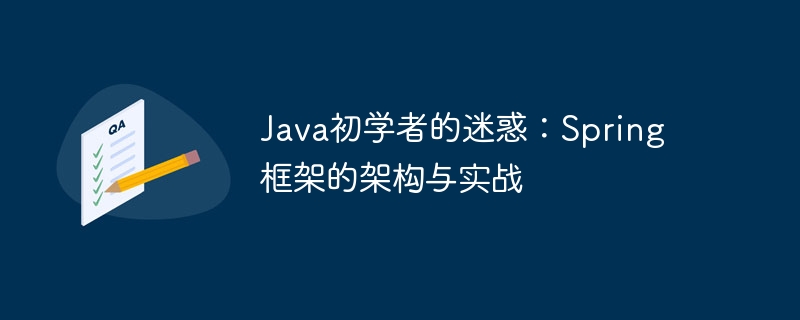Confusion for Java Beginners: Architecture and Practice of Spring Framework
Spring framework is a multi-level Java application framework that provides enterprise-level application development support. Its architecture includes: core container (Bean management), Web layer (Web application support), persistence layer (interaction with database), AOP layer (aspect-oriented programming), and test layer (testing and simulation). Practical cases demonstrate the use of core components such as Spring Bean creation, dependency injection, and database access. An in-depth understanding of the Spring framework's architecture and features will help beginners build robust Java applications.

Confusion for Java Beginners: Architecture and Practice of Spring Framework
Introduction
Spring framework is a powerful Java application framework that provides comprehensive support for enterprise-level application development. For beginners, understanding the vast architecture and numerous components of the Spring Framework can be confusing. This article aims to clarify the architecture and basic components of the Spring framework through intuitive explanations and practical cases.
Architecture Overview
The Spring framework adopts a layered architecture, with each layer providing different core services:
- Core container : Manage Bean life cycle, dependency injection and configuration.
- Web layer: Provides support for web application development, such as MVC and REST.
- Persistence layer: Simplifies interaction with relational databases or other persistence mechanisms.
- AOP layer: Enables aspect-oriented programming for interception and enhanced method execution.
- Testing layer: Provides testing and simulation tools.
Practical case
Create Spring Bean:
// Bean类
public class UserService {
private String name;
public String getName() {
return name;
}
public void setName(String name) {
this.name = name;
}
}
// 配置类
@Configuration
public class AppConfig {
@Bean
public UserService userService() {
return new UserService();
}
}Dependency injection:
// 控制器类
@Controller
public class HomeController {
@Autowired
private UserService userService;
@GetMapping("/")
public String home() {
return "welcome";
}
}Database access:
// 数据访问对象类
@Repository
public class UserRepositoryImpl implements UserRepository {
@Autowired
private JdbcTemplate jdbcTemplate;
@Override
public User findByName(String name) {
return jdbcTemplate.queryForObject("SELECT * FROM users WHERE name=?", new Object[]{name}, User.class);
}
}Conclusion
Through this practical case, we demonstrated the key components of the Spring framework and their Application in application development. A deep understanding of the Spring Framework's architecture and core features will enable beginners to build robust and maintainable Java applications.
The above is the detailed content of Confusion for Java Beginners: Architecture and Practice of Spring Framework. For more information, please follow other related articles on the PHP Chinese website!

Hot AI Tools

Undresser.AI Undress
AI-powered app for creating realistic nude photos

AI Clothes Remover
Online AI tool for removing clothes from photos.

Undress AI Tool
Undress images for free

Clothoff.io
AI clothes remover

AI Hentai Generator
Generate AI Hentai for free.

Hot Article

Hot Tools

Notepad++7.3.1
Easy-to-use and free code editor

SublimeText3 Chinese version
Chinese version, very easy to use

Zend Studio 13.0.1
Powerful PHP integrated development environment

Dreamweaver CS6
Visual web development tools

SublimeText3 Mac version
God-level code editing software (SublimeText3)

Hot Topics
 Square Root in Java
Aug 30, 2024 pm 04:26 PM
Square Root in Java
Aug 30, 2024 pm 04:26 PM
Guide to Square Root in Java. Here we discuss how Square Root works in Java with example and its code implementation respectively.
 Perfect Number in Java
Aug 30, 2024 pm 04:28 PM
Perfect Number in Java
Aug 30, 2024 pm 04:28 PM
Guide to Perfect Number in Java. Here we discuss the Definition, How to check Perfect number in Java?, examples with code implementation.
 Random Number Generator in Java
Aug 30, 2024 pm 04:27 PM
Random Number Generator in Java
Aug 30, 2024 pm 04:27 PM
Guide to Random Number Generator in Java. Here we discuss Functions in Java with examples and two different Generators with ther examples.
 Weka in Java
Aug 30, 2024 pm 04:28 PM
Weka in Java
Aug 30, 2024 pm 04:28 PM
Guide to Weka in Java. Here we discuss the Introduction, how to use weka java, the type of platform, and advantages with examples.
 Smith Number in Java
Aug 30, 2024 pm 04:28 PM
Smith Number in Java
Aug 30, 2024 pm 04:28 PM
Guide to Smith Number in Java. Here we discuss the Definition, How to check smith number in Java? example with code implementation.
 Java Spring Interview Questions
Aug 30, 2024 pm 04:29 PM
Java Spring Interview Questions
Aug 30, 2024 pm 04:29 PM
In this article, we have kept the most asked Java Spring Interview Questions with their detailed answers. So that you can crack the interview.
 Break or return from Java 8 stream forEach?
Feb 07, 2025 pm 12:09 PM
Break or return from Java 8 stream forEach?
Feb 07, 2025 pm 12:09 PM
Java 8 introduces the Stream API, providing a powerful and expressive way to process data collections. However, a common question when using Stream is: How to break or return from a forEach operation? Traditional loops allow for early interruption or return, but Stream's forEach method does not directly support this method. This article will explain the reasons and explore alternative methods for implementing premature termination in Stream processing systems. Further reading: Java Stream API improvements Understand Stream forEach The forEach method is a terminal operation that performs one operation on each element in the Stream. Its design intention is
 Java Made Simple: A Beginner's Guide to Programming Power
Oct 11, 2024 pm 06:30 PM
Java Made Simple: A Beginner's Guide to Programming Power
Oct 11, 2024 pm 06:30 PM
Java Made Simple: A Beginner's Guide to Programming Power Introduction Java is a powerful programming language used in everything from mobile applications to enterprise-level systems. For beginners, Java's syntax is simple and easy to understand, making it an ideal choice for learning programming. Basic Syntax Java uses a class-based object-oriented programming paradigm. Classes are templates that organize related data and behavior together. Here is a simple Java class example: publicclassPerson{privateStringname;privateintage;






